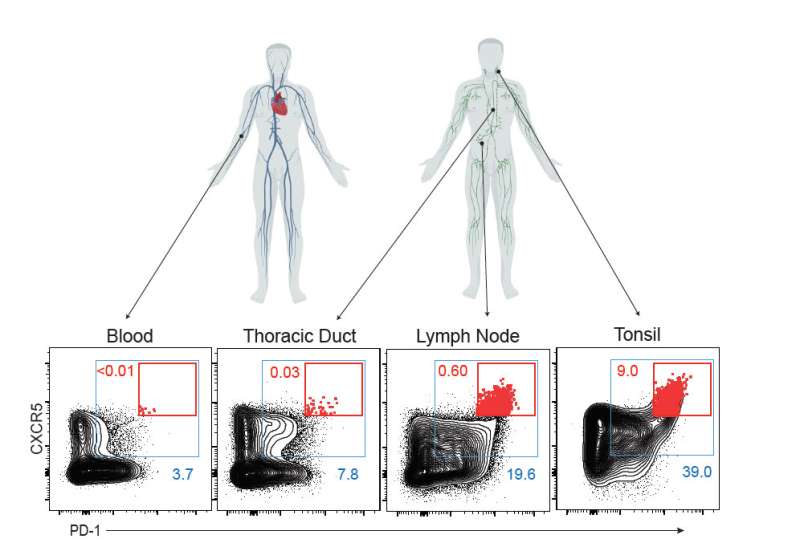Peering into the soul of the immune system to better fight disease

A rare, short-lived population of immune cells in the bloodstream may serve as 'periscopes' to monitor immune status via lymph nodes deep inside the body, according to researchers in the Perelman School of Medicine at the University of Pennsylvania. Their findings are published this month in the Journal of Clinical Investigation (JCI).
"This finding paves the way for using blood samples to provide a snapshot of whole-body immunity," said the study's co-first author Laura Vella. MD, Ph.D., a physician-scientist who performed this work in the lab of senior author E. John Wherry, Ph.D., chair of the department of Systems Pharmacology and Translational Therapeutics. Vella is also a pediatric infectious diseases physician at Children's Hospital of Philadelphia (CHOP).
Researchers say this work could help better define and monitor the condition of the immune system in vulnerable groups, such as infants and small children, the elderly, patients taking immune-suppression drugs, and those with autoimmune-based disorders like inflammatory bowel disease (IBD).
"It's as if we're trying to find the toxins draining from a single pipe into the Great Lakes—how do we find and characterize what is originating from that one spot in the water of an entire glacial lake?" Wherry said. "The cells we're looking for in the bloodstream are 0.1 percent of all cell types circulating in the blood. But our 'periscope' allows us see what that rare cell type can tell us about immune system events that have happened in a distant part of the body."
The elusive cell population described in this study are T follicular helper cells (Tfh). These are a subset of immune T cells required for B cells in the germinal centers (GC) of lymph nodes to make antibodies that fight germs and other outside invaders. Some Tfh cells in lymph nodes uniquely express the surface receptor protein CXCR5 and the inhibitory molecule PD-1. Blood does contain some Tfh cells with theses markers; however, scientists have long debated whether Tfh cells exit lymph nodes and circulate in the blood with traces of their original markers.
To answer this question, the team assessed the cell surface markers of Tfhs collected from human thoracic ducts—the main, yet difficult to access, "drainpipe" carrying fluid from the lymph system to the blood stream.
To learn how characteristics of Tfh in blood connect to the lymph system, the team compared Tfhs from lymph node GCs to Tfh cells in lymph fluid and to those in the blood. The team consistently identified "CXCR5-bright PD-1-bright" Tfh cells in lymph fluid at the duct. These doubly labeled Tfhs shared many epigenetic features and expressed similar proteins with Tfh cells in the GC. This means that the Tfhs sampled in the lymphatic duct are cellular intermediates connecting the biology of Tfhs in lymph tissue to Tfhs in blood, ultimately putting to rest the doubt that Tfhs in the blood reflect what happened in the lymph in the immediate past.
The team sees their new-found ability to match more easily obtained samples in the blood with earlier immune events deep in the node as being clinically useful for a variety of applications. From assessing when patients are ready to receive vaccines after bone marrow transplants to measuring how first-line immune treatments for people with IBD or certain types of cancers affect the broader immune system, use of their new "periscope" approach opens the door for more personalized treatment plans.
More information: Laura A. Vella et al. T follicular helper cells in human efferent lymph retain lymphoid characteristics, Journal of Clinical Investigation (2019). DOI: 10.1172/JCI125628


















